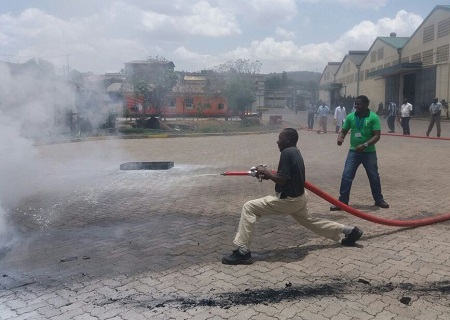Fire drills are essential in any workplace or public building for practicing what to do in the event of a fire. They are also a legal requirement for different countries and in Kenya the OSHA Act 2007 gives the guidelines and all employees in a company must participate. https://youtu.be/MZVpCDgx2Zs
Fire drills are for more than fires. Knowing the evacuation routes of a building will help in the event of a power outage, gas or chemical leak, or other emergency situation that can occur at the office. Fire drills ensure that employees exit the building in a timely fashion and know their team’s designated meeting area, which helps the rescue effort in the event an employee is unaccounted for during an actual emergency at the business.
I have been part of the teams that helped organize fire drills e.g Kenya Railways Corporation, Coopers Kenya, Villa Rosa Kempinsky, TetraPack Ltd, KUSSCO, Biersdorf Ltd etc. From the experience and the reaction of the staff, I recommend more seriousness to be put in this area and as per the legislation; every company should plan to have at least two Fire drills per year and conduct Fire safety and first aid training before conducting the drills. Fire incidents have a great effect and can lead to loss of life and property.
REASONS FOR CONDUCTING FIRE DRILLS
There are several reasons why fire drills are important; firstly fire drills are an opportunity to practice evacuation procedures to make sure all staff are familiar with them. They get staff used to exiting a building quickly and therefore in a real life situation panic will be reduced, as everyone will know what they need to do. Fire drills are also useful for testing escape routes to evaluate their effectiveness. Fire drills will enable employees to calmly and safely exit a building in case of an emergency.
During fire drills, checks can also be carried out on alarm systems to ensure they are working correctly and that emergency exits are unobstructed. Overall fire drills help improve safety, so that you will be best prepared if a real fire does occur.
Ideally you should aim to have two fire drills a year at your premises, although this may vary depending on what has been set out in your company’s risk assessment. If you employ shift workers, appropriate arrangements should be made to ensure all staff participate in at least two fire drill per year.
There are arguments for and against making people aware of fire drills before they take place. Some people argue that not informing staff gives an element of surprise, so that people take drills more seriously. However this can also have the opposite effect in a real fire, as on hearing the alarm people may think that it is only a drill.
The advantage of informing all staff of fire drills beforehand is that firstly, they will not panic, which avoids potential injuries that could be caused in a rush to exit a building. Secondly if the alarm sounds without a prior warning, there will be no ambiguity as to if it is a drill or not and people will behave appropriately. In public places such as shopping centres, it is advisable to make members of the public aware when a drill is about to take place.
They help to monitor and evaluate whether staff/participants can safely, promptly and effectively respond to a fire incident.
RISK ASSESSMENTS
Risk assessment helps you to identify the various available hazards at the workplace and take the necessary measures to remove, reduce or isolate these hazards. They also help you chose the necessary training for the staff as a Training Needs assessor will be guided by this to advice on the appropriate trainings for the staff exposed to these risks.
Inevitably when storing flammable substances, particularly large quantities in commercial and public environments, this will need to be identified in your fire risk assessment. You should outline, the steps that you will take to reduce the potential danger around the presence of these materials.
It’s highly recommended to have a full risk assessment carried out on your premises, particularly if you are storing substances that present a fire risk e.g explosives, highly flammable materials etc.
PREPARING FOR A FIRE DRILL
When you are planning a fire drill you should decide on something specific that you are going to monitor. This could be a specific aspect of your escape plan that you have highlighted as needing improvement or a more general goal, such as reducing the amount of time it takes for everyone to exit the building.
Amongst the staff, a team of fire marshals with a chief fire marshall and deputy in charge, should be appointed to supervise fire drills and check that everyone gets out safely. All marshals will require special training so that they can carry out their duties safely and effectively. Deputies should be given the opportunity to participate in fire drills so they can familiarize themselves with their role in case of the absence of the chief fire marshal if a real fire occurs.
If you have a system that automatically informs the fire service when the alarm is triggered, you need to take appropriate measures to stop this from causing the Fire Brigade a wasted journey. Take any systems off line before the fire drill but be sure to get them back up and running once the drill has finished. You should also notify people in nearby buildings of the drill date and time beforehand so that when they hear the fire alarm, they know that there is not a real fire.
ACTION DURING A FIRE DRILL
To monitor fire drills, observers should be placed at points around the building in areas such as stairwells to look for good and bad practices. Any room for improvement can be noted and then mentioned at a debriefing meeting after the drill.
In buildings where there are more than one exit route, the main exits should be blocked off to encourage staff to use alternative escape routes as in a real fire, parts of the building could be impassable due to fire or smoke.
Set a stopwatch to record how long the full evacuation takes, fire marshals should do a roll call and tick people off to make sure everyone is out of the building. Before exiting themselves, fire marshals should do quick sweep of the building including the toilets to check no one is trapped inside.
Debriefing should take place after the fire drill to look at the findings of the observers and evaluate the effectiveness of the evacuation procedures. Particular attention should be made to those points that were highlighted for improvement in the initial planning. To get a better idea of how successful the drill was, you could also invite staff to share their ideas on how they think the drill could have been more effective.
Love them or hate them fire drills are an important part of fire safety and your workplace will be a safer place because of them.
You can visit your local Fire Safety advisers and Fire brigade team for more advise and direction on how to effectively organize for a fire drill. You can also contact me via info@ambstevembugua.co.ke for a fire safety awareness session for your staff or to assist you prepare for a fire drill.
Fire prevention is better than Fire Fighting. Let us embrace a culture of safety together.



















